
尉所港汾蜀号上学 国际财务管理 微型案例 Capital Crystal Inc.Using Currency Futures and Options Capital Crystal Inc.is a major importer of Crystal from Germany.The crystal is sold to prestigious retail stores throughout the U.S.The imports are denominated in German marks (DM).Every quarter,Capital needs DM 500 million.It is presently attempting to determine whether it should use currency futures or currency options to hedge imports three months from now.If it will hedge at all. The spot rate of the mark is $.60.A three-month futures contract on the mark is available for $.59 per unit.A call option on the mark is available with a three-month expiration date and an exercise price of $.60.The premium to be paid on the call option is $.01 per unit. Capital is very confident that the value of the mark will rise to at least $.62 in three months.It has been very accurate in its previous forecasts of the mark's value.The management style of Capital is very risk-averse.Managers receive a bonus at the end of the year if they satisfy minimal performance standards.The bonus is fixed,regardless of how high above the minimum level one's performance is.If performance is below the minimum,there is no bonus,and future advancement within the company is unlikely. a)As a financial manager of Capital,you have been assigned the task of choosing among three possible strategies:(1)hedge the DM position by purchasing futures,(2)hedge the DM position by purchasing call options,or(3) do not hedge.Offer your recommendation and justify it. b)Assume the previous information that was provided,except for this difference: Capital has revised its forecast of the mark to be worth $.57 three months from now.Given this revision,recommend whether Capital should (1)hedge the DM position by purchasing futures,(2)hedge the DM position by purchasing call options,or(3)not hedge.Justify your recommendation.Is your recommendation consistent with maximizing shareholder wealth? -1-
国际财务管理 微型案例 - 1 - Capital Crystal Inc. — Using Currency Futures and Options Capital Crystal Inc. is a major importer of Crystal from Germany. The crystal is sold to prestigious retail stores throughout the U.S. The imports are denominated in German marks (DM). Every quarter, Capital needs DM 500 million. It is presently attempting to determine whether it should use currency futures or currency options to hedge imports three months from now. If it will hedge at all. The spot rate of the mark is $.60. A three-month futures contract on the mark is available for $.59 per unit. A call option on the mark is available with a three-month expiration date and an exercise price of $.60. The premium to be paid on the call option is $.01 per unit. Capital is very confident that the value of the mark will rise to at least $.62 in three months. It has been very accurate in its previous forecasts of the mark’s value. The management style of Capital is very risk-averse. Managers receive a bonus at the end of the year if they satisfy minimal performance standards. The bonus is fixed, regardless of how high above the minimum level one’s performance is. If performance is below the minimum, there is no bonus, and future advancement within the company is unlikely. a) As a financial manager of Capital, you have been assigned the task of choosing among three possible strategies: (1) hedge the DM position by purchasing futures, (2) hedge the DM position by purchasing call options, or (3) do not hedge. Offer your recommendation and justify it. b) Assume the previous information that was provided, except for this difference: Capital has revised its forecast of the mark to be worth $.57 three months from now. Given this revision, recommend whether Capital should (1) hedge the DM position by purchasing futures, (2) hedge the DM position by purchasing call options, or (3) not hedge. Justify your recommendation. Is your recommendation consistent with maximizing shareholder wealth?
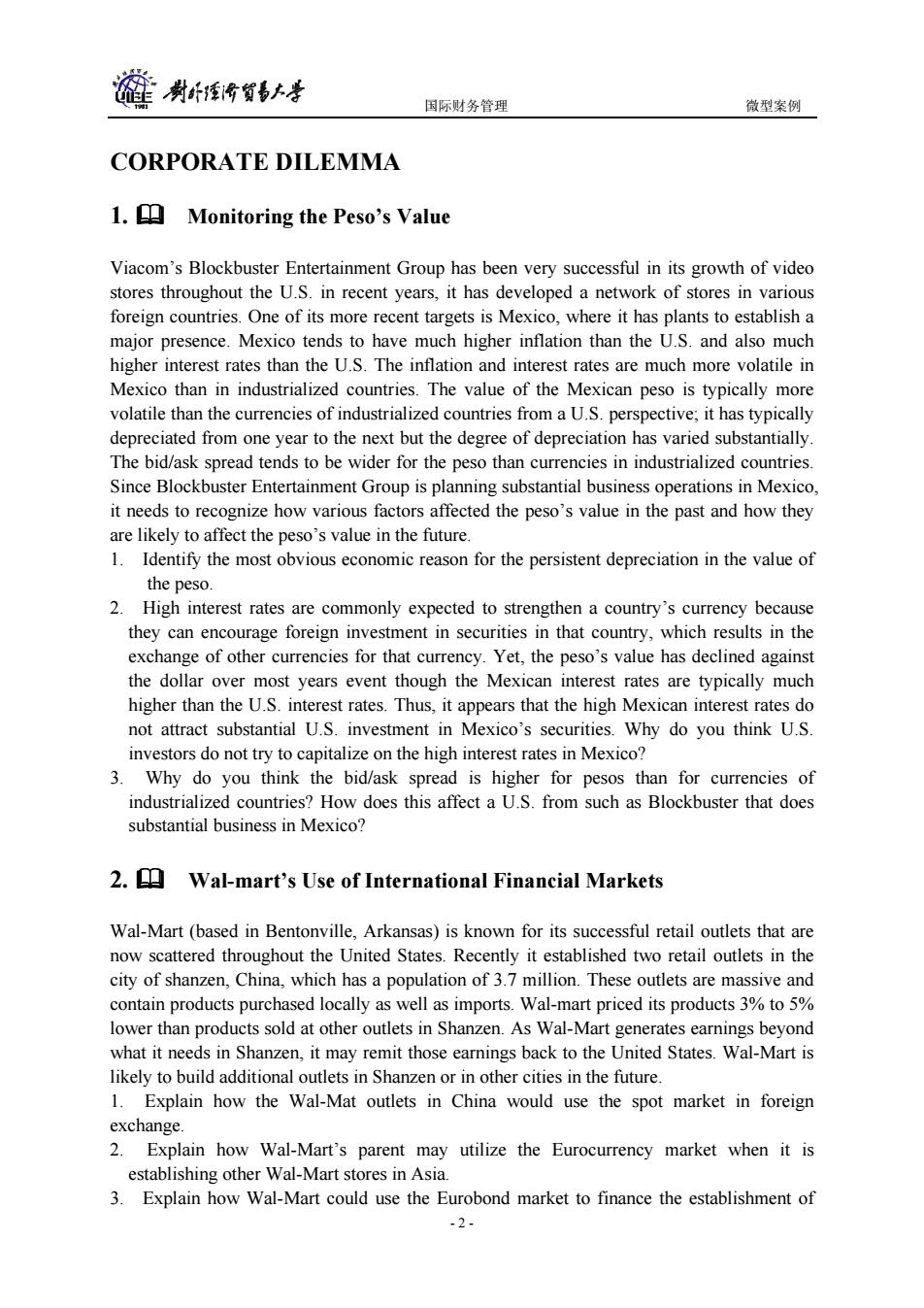
链岗纤将贸号上号 国际财务管理 微型案例 CORPORATE DILEMMA 1.Monitoring the Peso's Value Viacom's Blockbuster Entertainment Group has been very successful in its growth of video stores throughout the U.S.in recent years,it has developed a network of stores in various foreign countries.One of its more recent targets is Mexico,where it has plants to establish a major presence.Mexico tends to have much higher inflation than the U.S.and also much higher interest rates than the U.S.The inflation and interest rates are much more volatile in Mexico than in industrialized countries.The value of the Mexican peso is typically more volatile than the currencies of industrialized countries from a U.S.perspective;it has typically depreciated from one year to the next but the degree of depreciation has varied substantially. The bid/ask spread tends to be wider for the peso than currencies in industrialized countries. Since Blockbuster Entertainment Group is planning substantial business operations in Mexico, it needs to recognize how various factors affected the peso's value in the past and how they are likely to affect the peso's value in the future. 1.Identify the most obvious economic reason for the persistent depreciation in the value of the peso. 2.High interest rates are commonly expected to strengthen a country's currency because they can encourage foreign investment in securities in that country,which results in the exchange of other currencies for that currency.Yet,the peso's value has declined against the dollar over most years event though the Mexican interest rates are typically much higher than the U.S.interest rates.Thus,it appears that the high Mexican interest rates do not attract substantial U.S.investment in Mexico's securities.Why do you think U.S. investors do not try to capitalize on the high interest rates in Mexico? 3.Why do you think the bid/ask spread is higher for pesos than for currencies of industrialized countries?How does this affect a U.S.from such as Blockbuster that does substantial business in Mexico? 2.Wal-mart's Use of International Financial Markets Wal-Mart (based in Bentonville,Arkansas)is known for its successful retail outlets that are now scattered throughout the United States.Recently it established two retail outlets in the city of shanzen,China,which has a population of 3.7 million.These outlets are massive and contain products purchased locally as well as imports.Wal-mart priced its products 3%to 5% lower than products sold at other outlets in Shanzen.As Wal-Mart generates earnings beyond what it needs in Shanzen,it may remit those earnings back to the United States.Wal-Mart is likely to build additional outlets in Shanzen or in other cities in the future. 1.Explain how the Wal-Mat outlets in China would use the spot market in foreign exchange. 2.Explain how Wal-Mart's parent may utilize the Eurocurrency market when it is establishing other Wal-Mart stores in Asia. 3.Explain how Wal-Mart could use the Eurobond market to finance the establishment of -2-
国际财务管理 微型案例 - 2 - CORPORATE DILEMMA 1. Monitoring the Peso’s Value Viacom’s Blockbuster Entertainment Group has been very successful in its growth of video stores throughout the U.S. in recent years, it has developed a network of stores in various foreign countries. One of its more recent targets is Mexico, where it has plants to establish a major presence. Mexico tends to have much higher inflation than the U.S. and also much higher interest rates than the U.S. The inflation and interest rates are much more volatile in Mexico than in industrialized countries. The value of the Mexican peso is typically more volatile than the currencies of industrialized countries from a U.S. perspective; it has typically depreciated from one year to the next but the degree of depreciation has varied substantially. The bid/ask spread tends to be wider for the peso than currencies in industrialized countries. Since Blockbuster Entertainment Group is planning substantial business operations in Mexico, it needs to recognize how various factors affected the peso’s value in the past and how they are likely to affect the peso’s value in the future. 1. Identify the most obvious economic reason for the persistent depreciation in the value of the peso. 2. High interest rates are commonly expected to strengthen a country’s currency because they can encourage foreign investment in securities in that country, which results in the exchange of other currencies for that currency. Yet, the peso’s value has declined against the dollar over most years event though the Mexican interest rates are typically much higher than the U.S. interest rates. Thus, it appears that the high Mexican interest rates do not attract substantial U.S. investment in Mexico’s securities. Why do you think U.S. investors do not try to capitalize on the high interest rates in Mexico? 3. Why do you think the bid/ask spread is higher for pesos than for currencies of industrialized countries? How does this affect a U.S. from such as Blockbuster that does substantial business in Mexico? 2. Wal-mart’s Use of International Financial Markets Wal-Mart (based in Bentonville, Arkansas) is known for its successful retail outlets that are now scattered throughout the United States. Recently it established two retail outlets in the city of shanzen, China, which has a population of 3.7 million. These outlets are massive and contain products purchased locally as well as imports. Wal-mart priced its products 3% to 5% lower than products sold at other outlets in Shanzen. As Wal-Mart generates earnings beyond what it needs in Shanzen, it may remit those earnings back to the United States. Wal-Mart is likely to build additional outlets in Shanzen or in other cities in the future. 1. Explain how the Wal-Mat outlets in China would use the spot market in foreign exchange. 2. Explain how Wal-Mart’s parent may utilize the Eurocurrency market when it is establishing other Wal-Mart stores in Asia. 3. Explain how Wal-Mart could use the Eurobond market to finance the establishment of
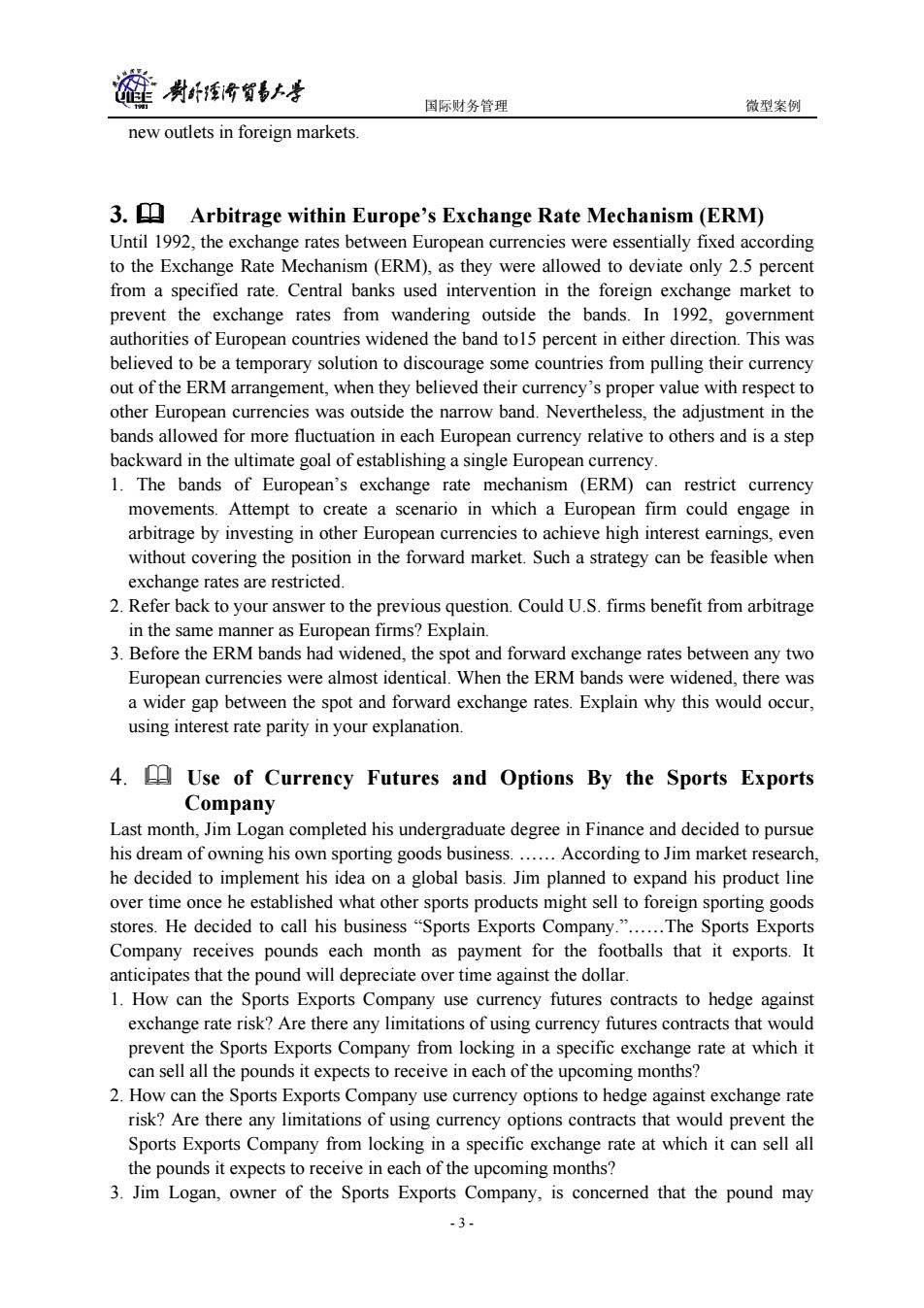
裢尉将发大号 国际财务管理 微型案例 new outlets in foreign markets 3.Arbitrage within Europe's Exchange Rate Mechanism(ERM) Until 1992,the exchange rates between European currencies were essentially fixed according to the Exchange Rate Mechanism(ERM),as they were allowed to deviate only 2.5 percent from a specified rate.Central banks used intervention in the foreign exchange market to prevent the exchange rates from wandering outside the bands.In 1992,government authorities of European countries widened the band tol5 percent in either direction.This was believed to be a temporary solution to discourage some countries from pulling their currency out of the ERM arrangement,when they believed their currency's proper value with respect to other European currencies was outside the narrow band.Nevertheless,the adjustment in the bands allowed for more fluctuation in each European currency relative to others and is a step backward in the ultimate goal of establishing a single European currency. 1.The bands of European's exchange rate mechanism (ERM)can restrict currency movements.Attempt to create a scenario in which a European firm could engage in arbitrage by investing in other European currencies to achieve high interest earnings,even without covering the position in the forward market.Such a strategy can be feasible when exchange rates are restricted. 2.Refer back to your answer to the previous question.Could U.S.firms benefit from arbitrage in the same manner as European firms?Explain. 3.Before the ERM bands had widened,the spot and forward exchange rates between any two European currencies were almost identical.When the ERM bands were widened,there was a wider gap between the spot and forward exchange rates.Explain why this would occur, using interest rate parity in your explanation. 4.Use of Currency Futures and Options By the Sports Exports Company Last month,Jim Logan completed his undergraduate degree in Finance and decided to pursue his dream of owning his own sporting goods business.......According to Jim market research, he decided to implement his idea on a global basis.Jim planned to expand his product line over time once he established what other sports products might sell to foreign sporting goods stores.He decided to call his business "Sports Exports Company."......The Sports Exports Company receives pounds each month as payment for the footballs that it exports.It anticipates that the pound will depreciate over time against the dollar. 1.How can the Sports Exports Company use currency futures contracts to hedge against exchange rate risk?Are there any limitations of using currency futures contracts that would prevent the Sports Exports Company from locking in a specific exchange rate at which it can sell all the pounds it expects to receive in each of the upcoming months? 2.How can the Sports Exports Company use currency options to hedge against exchange rate risk?Are there any limitations of using currency options contracts that would prevent the Sports Exports Company from locking in a specific exchange rate at which it can sell all the pounds it expects to receive in each of the upcoming months? 3.Jim Logan,owner of the Sports Exports Company,is concerned that the pound may -3
国际财务管理 微型案例 - 3 - new outlets in foreign markets. 3. Arbitrage within Europe’s Exchange Rate Mechanism (ERM) Until 1992, the exchange rates between European currencies were essentially fixed according to the Exchange Rate Mechanism (ERM), as they were allowed to deviate only 2.5 percent from a specified rate. Central banks used intervention in the foreign exchange market to prevent the exchange rates from wandering outside the bands. In 1992, government authorities of European countries widened the band to15 percent in either direction. This was believed to be a temporary solution to discourage some countries from pulling their currency out of the ERM arrangement, when they believed their currency’s proper value with respect to other European currencies was outside the narrow band. Nevertheless, the adjustment in the bands allowed for more fluctuation in each European currency relative to others and is a step backward in the ultimate goal of establishing a single European currency. 1. The bands of European’s exchange rate mechanism (ERM) can restrict currency movements. Attempt to create a scenario in which a European firm could engage in arbitrage by investing in other European currencies to achieve high interest earnings, even without covering the position in the forward market. Such a strategy can be feasible when exchange rates are restricted. 2. Refer back to your answer to the previous question. Could U.S. firms benefit from arbitrage in the same manner as European firms? Explain. 3. Before the ERM bands had widened, the spot and forward exchange rates between any two European currencies were almost identical. When the ERM bands were widened, there was a wider gap between the spot and forward exchange rates. Explain why this would occur, using interest rate parity in your explanation. 4. Use of Currency Futures and Options By the Sports Exports Company Last month, Jim Logan completed his undergraduate degree in Finance and decided to pursue his dream of owning his own sporting goods business. …… According to Jim market research, he decided to implement his idea on a global basis. Jim planned to expand his product line over time once he established what other sports products might sell to foreign sporting goods stores. He decided to call his business “Sports Exports Company.”……The Sports Exports Company receives pounds each month as payment for the footballs that it exports. It anticipates that the pound will depreciate over time against the dollar. 1. How can the Sports Exports Company use currency futures contracts to hedge against exchange rate risk? Are there any limitations of using currency futures contracts that would prevent the Sports Exports Company from locking in a specific exchange rate at which it can sell all the pounds it expects to receive in each of the upcoming months? 2. How can the Sports Exports Company use currency options to hedge against exchange rate risk? Are there any limitations of using currency options contracts that would prevent the Sports Exports Company from locking in a specific exchange rate at which it can sell all the pounds it expects to receive in each of the upcoming months? 3. Jim Logan, owner of the Sports Exports Company, is concerned that the pound may
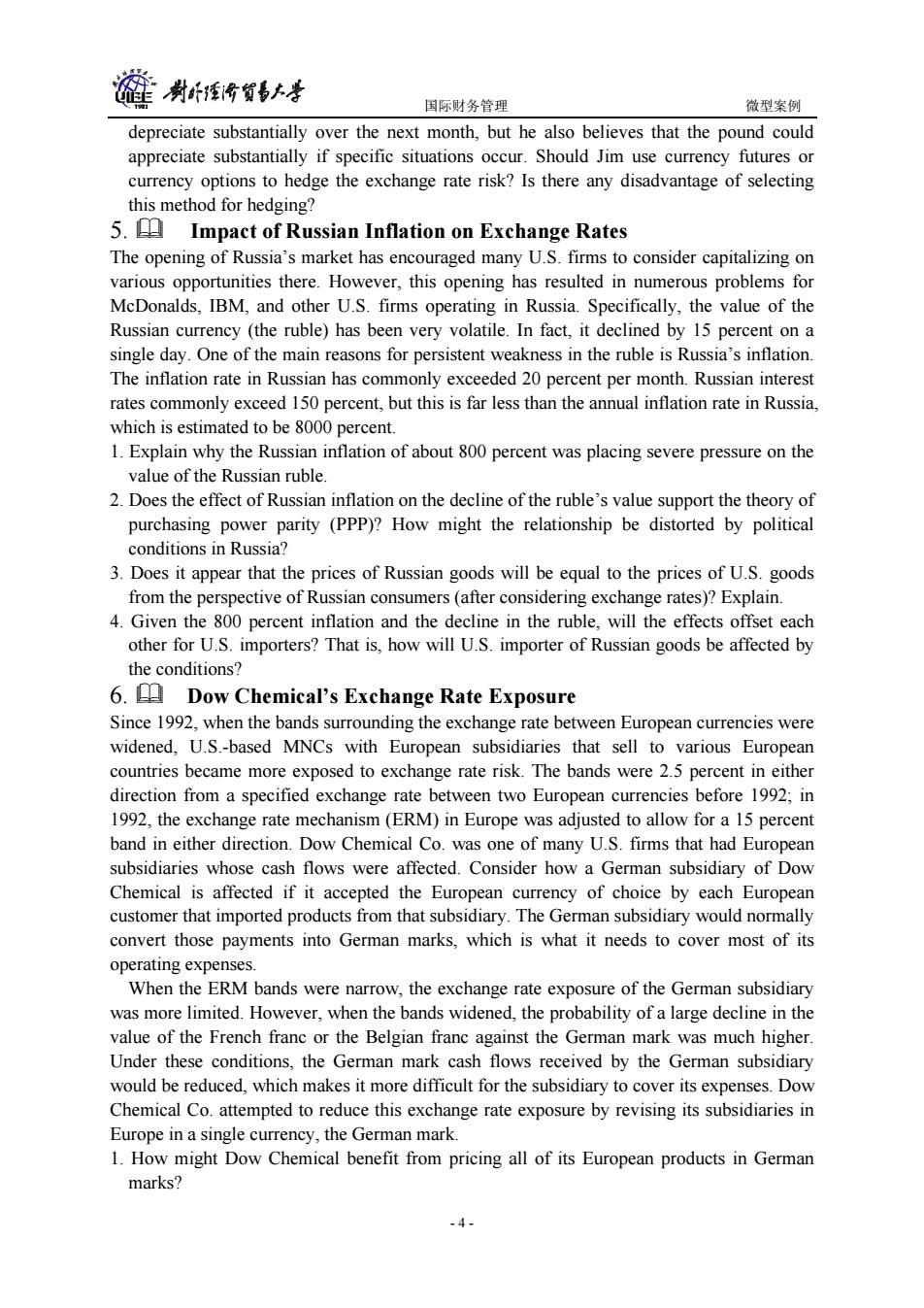
尉将发影大孝 国际财务管理 微型案例 depreciate substantially over the next month,but he also believes that the pound could appreciate substantially if specific situations occur.Should Jim use currency futures or currency options to hedge the exchange rate risk?Is there any disadvantage of selecting this method for hedging? 5.Impact of Russian Inflation on Exchange Rates The opening of Russia's market has encouraged many U.S.firms to consider capitalizing on various opportunities there.However,this opening has resulted in numerous problems for McDonalds,IBM,and other U.S.firms operating in Russia.Specifically,the value of the Russian currency (the ruble)has been very volatile.In fact,it declined by 15 percent on a single day.One of the main reasons for persistent weakness in the ruble is Russia's inflation. The inflation rate in Russian has commonly exceeded 20 percent per month.Russian interest rates commonly exceed 150 percent,but this is far less than the annual inflation rate in Russia, which is estimated to be 8000 percent. 1.Explain why the Russian inflation of about 800 percent was placing severe pressure on the value of the Russian ruble. 2.Does the effect of Russian inflation on the decline of the ruble's value support the theory of purchasing power parity (PPP)?How might the relationship be distorted by political conditions in Russia? 3.Does it appear that the prices of Russian goods will be equal to the prices of U.S.goods from the perspective of Russian consumers (after considering exchange rates)?Explain. 4.Given the 800 percent inflation and the decline in the ruble,will the effects offset each other for U.S.importers?That is,how will U.S.importer of Russian goods be affected by the conditions? 6.Dow Chemical's Exchange Rate Exposure Since 1992,when the bands surrounding the exchange rate between European currencies were widened,U.S.-based MNCs with European subsidiaries that sell to various European countries became more exposed to exchange rate risk.The bands were 2.5 percent in either direction from a specified exchange rate between two European currencies before 1992;in 1992,the exchange rate mechanism(ERM)in Europe was adjusted to allow for a 15 percent band in either direction.Dow Chemical Co.was one of many U.S.firms that had European subsidiaries whose cash flows were affected.Consider how a German subsidiary of Dow Chemical is affected if it accepted the European currency of choice by each European customer that imported products from that subsidiary.The German subsidiary would normally convert those payments into German marks,which is what it needs to cover most of its operating expenses. When the ERM bands were narrow,the exchange rate exposure of the German subsidiary was more limited.However,when the bands widened,the probability of a large decline in the value of the French franc or the Belgian franc against the German mark was much higher. Under these conditions,the German mark cash flows received by the German subsidiary would be reduced,which makes it more difficult for the subsidiary to cover its expenses.Dow Chemical Co.attempted to reduce this exchange rate exposure by revising its subsidiaries in Europe in a single currency,the German mark. 1.How might Dow Chemical benefit from pricing all of its European products in German marks? -4-
国际财务管理 微型案例 - 4 - depreciate substantially over the next month, but he also believes that the pound could appreciate substantially if specific situations occur. Should Jim use currency futures or currency options to hedge the exchange rate risk? Is there any disadvantage of selecting this method for hedging? 5. Impact of Russian Inflation on Exchange Rates The opening of Russia’s market has encouraged many U.S. firms to consider capitalizing on various opportunities there. However, this opening has resulted in numerous problems for McDonalds, IBM, and other U.S. firms operating in Russia. Specifically, the value of the Russian currency (the ruble) has been very volatile. In fact, it declined by 15 percent on a single day. One of the main reasons for persistent weakness in the ruble is Russia’s inflation. The inflation rate in Russian has commonly exceeded 20 percent per month. Russian interest rates commonly exceed 150 percent, but this is far less than the annual inflation rate in Russia, which is estimated to be 8000 percent. 1. Explain why the Russian inflation of about 800 percent was placing severe pressure on the value of the Russian ruble. 2. Does the effect of Russian inflation on the decline of the ruble’s value support the theory of purchasing power parity (PPP)? How might the relationship be distorted by political conditions in Russia? 3. Does it appear that the prices of Russian goods will be equal to the prices of U.S. goods from the perspective of Russian consumers (after considering exchange rates)? Explain. 4. Given the 800 percent inflation and the decline in the ruble, will the effects offset each other for U.S. importers? That is, how will U.S. importer of Russian goods be affected by the conditions? 6. Dow Chemical’s Exchange Rate Exposure Since 1992, when the bands surrounding the exchange rate between European currencies were widened, U.S.-based MNCs with European subsidiaries that sell to various European countries became more exposed to exchange rate risk. The bands were 2.5 percent in either direction from a specified exchange rate between two European currencies before 1992; in 1992, the exchange rate mechanism (ERM) in Europe was adjusted to allow for a 15 percent band in either direction. Dow Chemical Co. was one of many U.S. firms that had European subsidiaries whose cash flows were affected. Consider how a German subsidiary of Dow Chemical is affected if it accepted the European currency of choice by each European customer that imported products from that subsidiary. The German subsidiary would normally convert those payments into German marks, which is what it needs to cover most of its operating expenses. When the ERM bands were narrow, the exchange rate exposure of the German subsidiary was more limited. However, when the bands widened, the probability of a large decline in the value of the French franc or the Belgian franc against the German mark was much higher. Under these conditions, the German mark cash flows received by the German subsidiary would be reduced, which makes it more difficult for the subsidiary to cover its expenses. Dow Chemical Co. attempted to reduce this exchange rate exposure by revising its subsidiaries in Europe in a single currency, the German mark. 1. How might Dow Chemical benefit from pricing all of its European products in German marks?
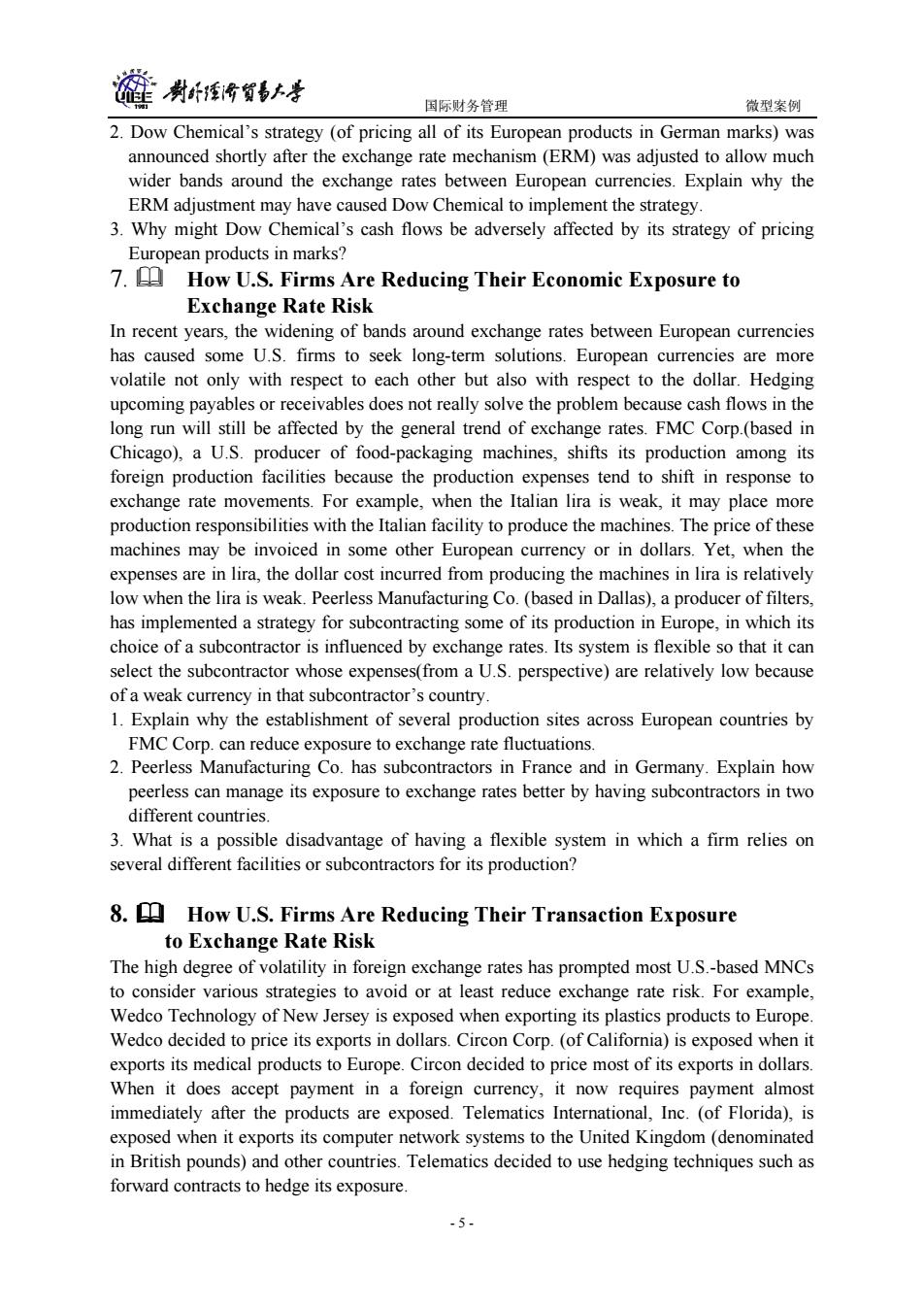
裢尉纤将贺大生 国际财务管理 微型案例 2.Dow Chemical's strategy (of pricing all of its European products in German marks)was announced shortly after the exchange rate mechanism(ERM)was adjusted to allow much wider bands around the exchange rates between European currencies.Explain why the ERM adjustment may have caused Dow Chemical to implement the strategy. 3.Why might Dow Chemical's cash flows be adversely affected by its strategy of pricing European products in marks? 7.How U.S.Firms Are Reducing Their Economic Exposure to Exchange Rate Risk In recent years,the widening of bands around exchange rates between European currencies has caused some U.S.firms to seek long-term solutions.European currencies are more volatile not only with respect to each other but also with respect to the dollar.Hedging upcoming payables or receivables does not really solve the problem because cash flows in the long run will still be affected by the general trend of exchange rates.FMC Corp.(based in Chicago),a U.S.producer of food-packaging machines,shifts its production among its foreign production facilities because the production expenses tend to shift in response to exchange rate movements.For example,when the Italian lira is weak,it may place more production responsibilities with the Italian facility to produce the machines.The price of these machines may be invoiced in some other European currency or in dollars.Yet,when the expenses are in lira,the dollar cost incurred from producing the machines in lira is relatively low when the lira is weak.Peerless Manufacturing Co.(based in Dallas),a producer of filters, has implemented a strategy for subcontracting some of its production in Europe,in which its choice of a subcontractor is influenced by exchange rates.Its system is flexible so that it can select the subcontractor whose expenses(from a U.S.perspective)are relatively low because of a weak currency in that subcontractor's country. 1.Explain why the establishment of several production sites across European countries by FMC Corp.can reduce exposure to exchange rate fluctuations. 2.Peerless Manufacturing Co.has subcontractors in France and in Germany.Explain how peerless can manage its exposure to exchange rates better by having subcontractors in two different countries. 3.What is a possible disadvantage of having a flexible system in which a firm relies on several different facilities or subcontractors for its production? 8.How U.S.Firms Are Reducing Their Transaction Exposure to Exchange Rate Risk The high degree of volatility in foreign exchange rates has prompted most U.S.-based MNCs to consider various strategies to avoid or at least reduce exchange rate risk.For example, Wedco Technology of New Jersey is exposed when exporting its plastics products to Europe. Wedco decided to price its exports in dollars.Circon Corp.(of California)is exposed when it exports its medical products to Europe.Circon decided to price most of its exports in dollars. When it does accept payment in a foreign currency,it now requires payment almost immediately after the products are exposed.Telematics International,Inc.(of Florida),is exposed when it exports its computer network systems to the United Kingdom(denominated in British pounds)and other countries.Telematics decided to use hedging techniques such as forward contracts to hedge its exposure. -5-
国际财务管理 微型案例 - 5 - 2. Dow Chemical’s strategy (of pricing all of its European products in German marks) was announced shortly after the exchange rate mechanism (ERM) was adjusted to allow much wider bands around the exchange rates between European currencies. Explain why the ERM adjustment may have caused Dow Chemical to implement the strategy. 3. Why might Dow Chemical’s cash flows be adversely affected by its strategy of pricing European products in marks? 7. How U.S. Firms Are Reducing Their Economic Exposure to Exchange Rate Risk In recent years, the widening of bands around exchange rates between European currencies has caused some U.S. firms to seek long-term solutions. European currencies are more volatile not only with respect to each other but also with respect to the dollar. Hedging upcoming payables or receivables does not really solve the problem because cash flows in the long run will still be affected by the general trend of exchange rates. FMC Corp.(based in Chicago), a U.S. producer of food-packaging machines, shifts its production among its foreign production facilities because the production expenses tend to shift in response to exchange rate movements. For example, when the Italian lira is weak, it may place more production responsibilities with the Italian facility to produce the machines. The price of these machines may be invoiced in some other European currency or in dollars. Yet, when the expenses are in lira, the dollar cost incurred from producing the machines in lira is relatively low when the lira is weak. Peerless Manufacturing Co. (based in Dallas), a producer of filters, has implemented a strategy for subcontracting some of its production in Europe, in which its choice of a subcontractor is influenced by exchange rates. Its system is flexible so that it can select the subcontractor whose expenses(from a U.S. perspective) are relatively low because of a weak currency in that subcontractor’s country. 1. Explain why the establishment of several production sites across European countries by FMC Corp. can reduce exposure to exchange rate fluctuations. 2. Peerless Manufacturing Co. has subcontractors in France and in Germany. Explain how peerless can manage its exposure to exchange rates better by having subcontractors in two different countries. 3. What is a possible disadvantage of having a flexible system in which a firm relies on several different facilities or subcontractors for its production? 8. How U.S. Firms Are Reducing Their Transaction Exposure to Exchange Rate Risk The high degree of volatility in foreign exchange rates has prompted most U.S.-based MNCs to consider various strategies to avoid or at least reduce exchange rate risk. For example, Wedco Technology of New Jersey is exposed when exporting its plastics products to Europe. Wedco decided to price its exports in dollars. Circon Corp. (of California) is exposed when it exports its medical products to Europe. Circon decided to price most of its exports in dollars. When it does accept payment in a foreign currency, it now requires payment almost immediately after the products are exposed. Telematics International, Inc. (of Florida), is exposed when it exports its computer network systems to the United Kingdom (denominated in British pounds) and other countries. Telematics decided to use hedging techniques such as forward contracts to hedge its exposure
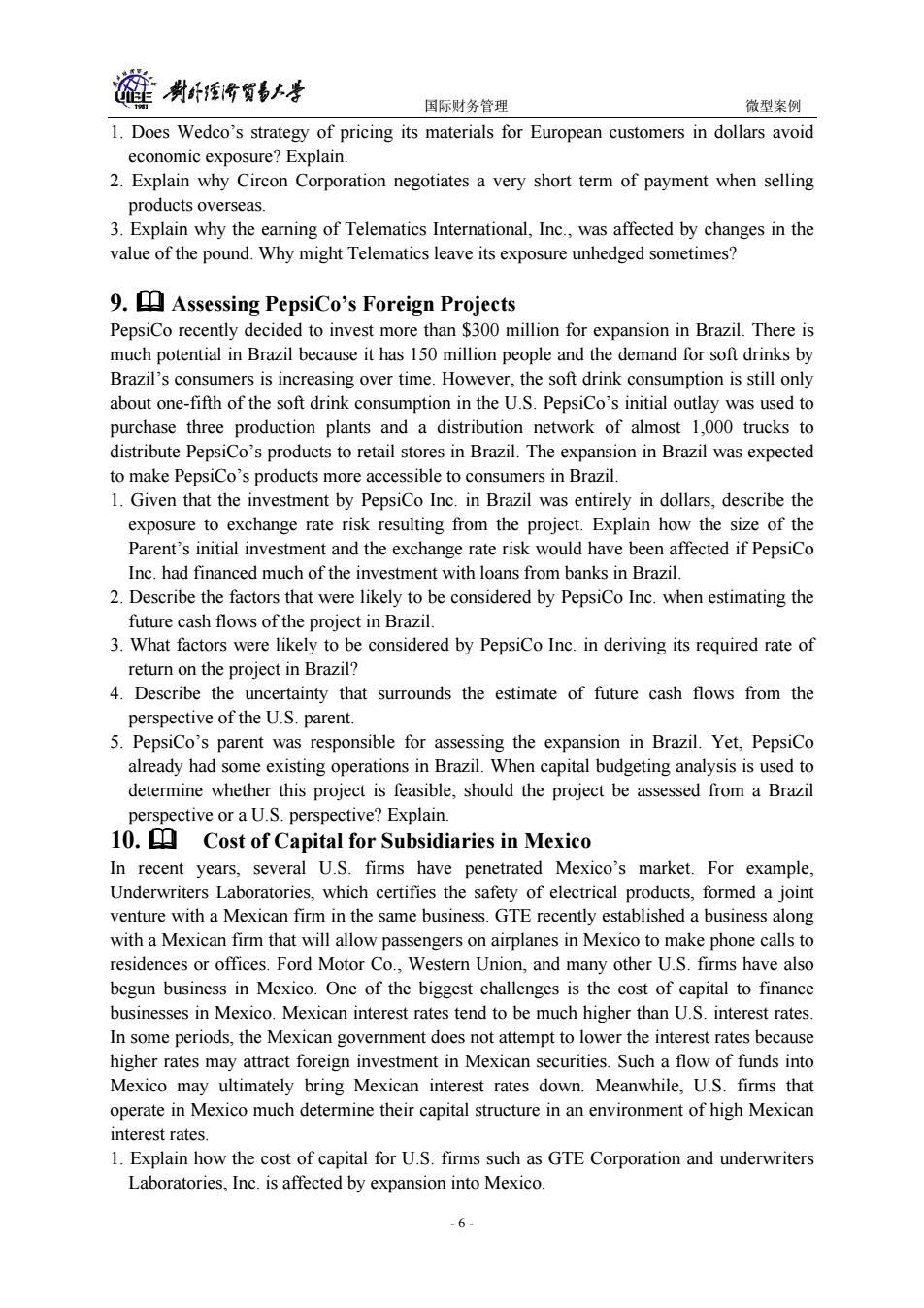
缝尉好有贺上号 国际财务管理 微型案例 1.Does Wedco's strategy of pricing its materials for European customers in dollars avoid economic exposure?Explain. 2.Explain why Circon Corporation negotiates a very short term of payment when selling products overseas. 3.Explain why the earning of Telematics International,Inc.,was affected by changes in the value of the pound.Why might Telematics leave its exposure unhedged sometimes? 9.Assessing PepsiCo's Foreign Projects PepsiCo recently decided to invest more than $300 million for expansion in Brazil.There is much potential in Brazil because it has 150 million people and the demand for soft drinks by Brazil's consumers is increasing over time.However,the soft drink consumption is still only about one-fifth of the soft drink consumption in the U.S.PepsiCo's initial outlay was used to purchase three production plants and a distribution network of almost 1,000 trucks to distribute PepsiCo's products to retail stores in Brazil.The expansion in Brazil was expected to make PepsiCo's products more accessible to consumers in Brazil. 1.Given that the investment by PepsiCo Inc.in Brazil was entirely in dollars,describe the exposure to exchange rate risk resulting from the project.Explain how the size of the Parent's initial investment and the exchange rate risk would have been affected if PepsiCo Inc.had financed much of the investment with loans from banks in Brazil. 2.Describe the factors that were likely to be considered by PepsiCo Inc.when estimating the future cash flows of the project in Brazil. 3.What factors were likely to be considered by PepsiCo Inc.in deriving its required rate of return on the project in Brazil? 4.Describe the uncertainty that surrounds the estimate of future cash flows from the perspective of the U.S.parent. 5.PepsiCo's parent was responsible for assessing the expansion in Brazil.Yet,PepsiCo already had some existing operations in Brazil.When capital budgeting analysis is used to determine whether this project is feasible,should the project be assessed from a Brazil perspective or a U.S.perspective?Explain. 10.Cost of Capital for Subsidiaries in Mexico In recent years,several U.S.firms have penetrated Mexico's market.For example, Underwriters Laboratories,which certifies the safety of electrical products,formed a joint venture with a Mexican firm in the same business.GTE recently established a business along with a Mexican firm that will allow passengers on airplanes in Mexico to make phone calls to residences or offices.Ford Motor Co.,Western Union,and many other U.S.firms have also begun business in Mexico.One of the biggest challenges is the cost of capital to finance businesses in Mexico.Mexican interest rates tend to be much higher than U.S.interest rates. In some periods,the Mexican government does not attempt to lower the interest rates because higher rates may attract foreign investment in Mexican securities.Such a flow of funds into Mexico may ultimately bring Mexican interest rates down.Meanwhile,U.S.firms that operate in Mexico much determine their capital structure in an environment of high Mexican interest rates. 1.Explain how the cost of capital for U.S.firms such as GTE Corporation and underwriters Laboratories,Inc.is affected by expansion into Mexico. -6-
国际财务管理 微型案例 - 6 - 1. Does Wedco’s strategy of pricing its materials for European customers in dollars avoid economic exposure? Explain. 2. Explain why Circon Corporation negotiates a very short term of payment when selling products overseas. 3. Explain why the earning of Telematics International, Inc., was affected by changes in the value of the pound. Why might Telematics leave its exposure unhedged sometimes? 9. Assessing PepsiCo’s Foreign Projects PepsiCo recently decided to invest more than $300 million for expansion in Brazil. There is much potential in Brazil because it has 150 million people and the demand for soft drinks by Brazil’s consumers is increasing over time. However, the soft drink consumption is still only about one-fifth of the soft drink consumption in the U.S. PepsiCo’s initial outlay was used to purchase three production plants and a distribution network of almost 1,000 trucks to distribute PepsiCo’s products to retail stores in Brazil. The expansion in Brazil was expected to make PepsiCo’s products more accessible to consumers in Brazil. 1. Given that the investment by PepsiCo Inc. in Brazil was entirely in dollars, describe the exposure to exchange rate risk resulting from the project. Explain how the size of the Parent’s initial investment and the exchange rate risk would have been affected if PepsiCo Inc. had financed much of the investment with loans from banks in Brazil. 2. Describe the factors that were likely to be considered by PepsiCo Inc. when estimating the future cash flows of the project in Brazil. 3. What factors were likely to be considered by PepsiCo Inc. in deriving its required rate of return on the project in Brazil? 4. Describe the uncertainty that surrounds the estimate of future cash flows from the perspective of the U.S. parent. 5. PepsiCo’s parent was responsible for assessing the expansion in Brazil. Yet, PepsiCo already had some existing operations in Brazil. When capital budgeting analysis is used to determine whether this project is feasible, should the project be assessed from a Brazil perspective or a U.S. perspective? Explain. 10. Cost of Capital for Subsidiaries in Mexico In recent years, several U.S. firms have penetrated Mexico’s market. For example, Underwriters Laboratories, which certifies the safety of electrical products, formed a joint venture with a Mexican firm in the same business. GTE recently established a business along with a Mexican firm that will allow passengers on airplanes in Mexico to make phone calls to residences or offices. Ford Motor Co., Western Union, and many other U.S. firms have also begun business in Mexico. One of the biggest challenges is the cost of capital to finance businesses in Mexico. Mexican interest rates tend to be much higher than U.S. interest rates. In some periods, the Mexican government does not attempt to lower the interest rates because higher rates may attract foreign investment in Mexican securities. Such a flow of funds into Mexico may ultimately bring Mexican interest rates down. Meanwhile, U.S. firms that operate in Mexico much determine their capital structure in an environment of high Mexican interest rates. 1. Explain how the cost of capital for U.S. firms such as GTE Corporation and underwriters Laboratories, Inc. is affected by expansion into Mexico
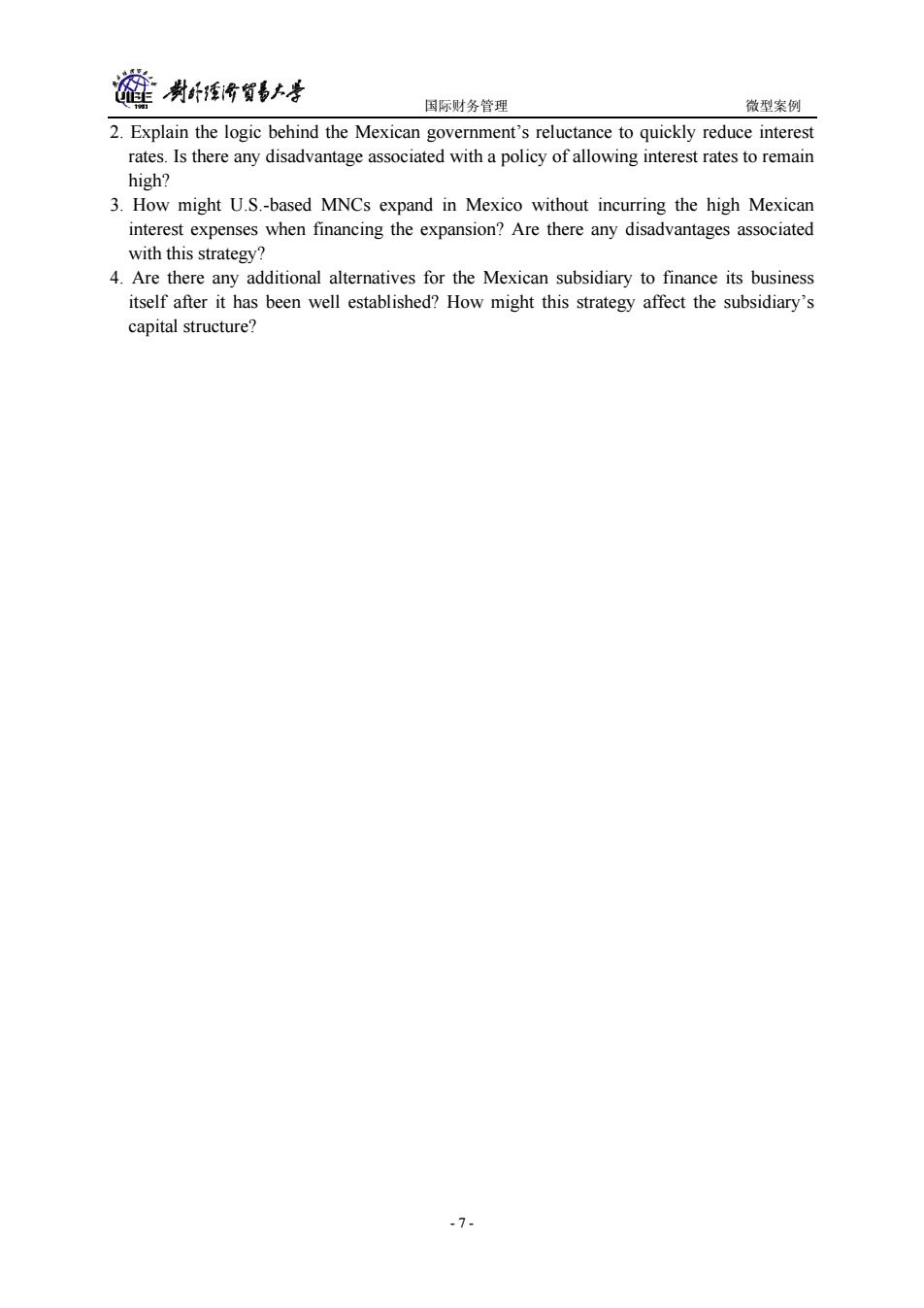
旌岗强有贺6大号 国际财务管理 微型案例 2.Explain the logic behind the Mexican government's reluctance to quickly reduce interest rates.Is there any disadvantage associated with a policy of allowing interest rates to remain high? 3.How might U.S.-based MNCs expand in Mexico without incurring the high Mexican interest expenses when financing the expansion?Are there any disadvantages associated with this strategy? 4.Are there any additional alternatives for the Mexican subsidiary to finance its business itself after it has been well established?How might this strategy affect the subsidiary's capital structure? -7-
国际财务管理 微型案例 - 7 - 2. Explain the logic behind the Mexican government’s reluctance to quickly reduce interest rates. Is there any disadvantage associated with a policy of allowing interest rates to remain high? 3. How might U.S.-based MNCs expand in Mexico without incurring the high Mexican interest expenses when financing the expansion? Are there any disadvantages associated with this strategy? 4. Are there any additional alternatives for the Mexican subsidiary to finance its business itself after it has been well established? How might this strategy affect the subsidiary’s capital structure?